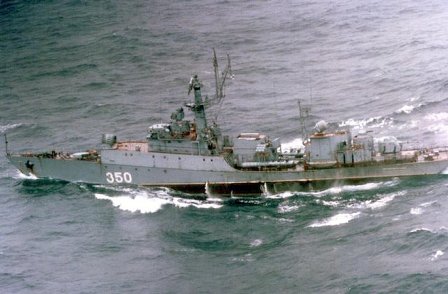Grisha-class
Summary
| Origin country | 🇷🇺 Russia |
| Category | Corvette |
| Subtype | Missile corvette |
| Manufacturer | Zelenodolsk Gorky Plant (340), Zelenodolsk; Leninska Kuznya (302), Kiev; Kirov Shipyard (876), Khabarovsk; Eastern Shipyard (602), Vladivostok |
| Year commissioned | 1970 |
| Units | JUNGA MONCHEGORSK, EYSK SNEZHNOGORSK, KASIMOV NARJAN MAR, MUROMETS BREST, SUZDALETS METEL, N… N… U200 LUTS’K, U202 TERNOPOL, U205 CHERNIGIV, U206 VINNITSYA |
| Current operators | 🇷🇺 Russia |
Description
The Grisha-class corvettes, also known by their Soviet designation Project 1124 Al'batros, are a series of anti-submarine warships that were constructed by the Soviet Union from 1970 to 1990, and subsequently by Russia and Ukraine. Their primary mission is anti-submarine warfare, although their small size and limited range confine them to operations in coastal waters. They are outfitted with an assortment of anti-submarine warfare (ASW) weapons including an SA-N-4 'Gecko' surface-to-air missile launcher. In addition, they feature retractable fin stabilizers for enhanced stability. While they are referred to as corvettes, the Soviet classification identified them as small anti-submarine ships. Russia plans to partially replace the Grisha class with the newer Steregushchiy-class corvette in its Navy.
The Grisha-class corvettes were designed with variations to meet different requirements and roles. The Grisha I subclass was built from 1970 to 1974, with a total of 12 ships, all decommissioned by 1999. Grisha II class vessels were constructed for the KGB border guard with a distinct P for "pogranichnyi" meaning "on the border." This class, consisting of 17 ships from the 1970s, featured a second 57 mm gun mount replacing the SA-N-4 missile system and was produced in Zelenodolsk and Vladivostok. Two were transferred to the Ukrainian Navy, and some may still serve in the Russian Maritime Border Guard.
Following this, the Grisha III class introduced several minor improvements, such as a 30 mm gun and updated electronics, during the late 1970s to early 1980s with a total of 34 ships built. Lithuania operated two of these ships until 2009. The Grisha IV class added just a single ship, which served as a test platform for the SA-N-9 missile system before being retired. The later Grisha V class, with 30 units constructed between 1985 and 1994, made further enhancements, including replacing the twin 57 mm guns with a single 76 mm gun. Post-Soviet Union dissolution, Ukrainian iterations of the Grisha V class were designated as 1124MU and include ships like Ternopil which joined the Ukrainian Navy in 2006.
Modernization efforts for the Grisha-class ships are ongoing, with Russian units updated with the "Tornado 2" combat system for firing "Zapad" type anti-submarine missiles. As of 2021, around twenty Grisha-class corvettes, mostly from the Grisha III subclass, are still active within the Russian Navy. Operating countries of the Grisha class have included the Soviet Union, Russia, Ukraine, and Lithuania.
Technical specifications
| Grisha | |
|---|---|
| Displacement | 1200 tons |
| Range | 7000 km at 22 knots |
| Crew | 60 members |
| Width | 9.8 m (32.2 ft) |
| Length | 71.6 m (234.9 ft) |
| Propulsion | 2 gas turbines with a power of 20,000 hp - 2 propellers |
| Armament | 1 SA-N-4 (20 missiles) + 2 SA-N-5 (IV 2) + 1 76mm AK-176 gun + 1 30mm AK-630 gun + 4 533mm T/ASM + 1 LR RBU 6000 + 2 underwater grenade launchers |
| Maximum speed | 34 knots |
Photo of Grisha class
